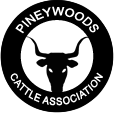D. P. Sponenberg
A few general issues are facing the Pineywoods breed, and the next decade will determine how much of the breed is brought into the future. Not only is it important to assure the breed numbers are up – it is also important to consider the genetic structure and genetic health of the breed. The discussion of those sorts of issues is detailed and complicated, and will be tackled in a series of articles. A few suggestions that are more general husbandry issues are the target of this short article.
One very practical issue that most (and really, all) breeders should address is what happens to the herd in the case of the death of the owner. This might be due to premature accident, or to the more expected (but no less tragic) demise of an elderly owner and breeder. In either event, the breed has seen the dispersal of too many old herds “over the scales.” With that dispersal comes the loss of carefully crafted genetic wealth. Every breeder should write out his desires for the dispersal of the herd – especially if the herd is to go to another interested breeder. Make sure that copies of this are with the general will of the breeder. This includes young breeders as well as old! If you are thinking of willing the cattle to a specific individual that is not a family member, then be sure to give that person as well as the family a copy of your wishes. I hope that this is never necessary – but it is better to be prepared for a tragedy than cleaning up after one!
A related issue is also important: every animal should be identified in an obvious manner. In some breeds this is done by branding, in others it is done by eartags or tattoos. Most breeders have a phenomenal ability to know their own animals – identification, pedigree, and performance – all by just looking at them and recognizing them as individuals. There is nothing wrong with this approach – unless the owner/breeder is for some reason unavailable. Ideally every animal should be identified so that any reasonably knowledgeable stranger could walk into the herd and match up animals with their idenfication details. This helps to link the animals to their own records. This is especially helpful in the case of accident or disability or other unforeseen disaster. Every animal should be identifed!
Many herds have both purebred and crossbred cattle. Mixing the two is not a bad strategy, but does raise the question of crossbred bulls in herds. Some bull calves are remarkably fast maturing and can settle cows as early as 9 months old. To avoid any question of this happening, crossbred bull calves need to be removed by 6 months old. Or, even better, ALL crossbred bull calves should be castrated while very young. This removes any chance of accidental matings, and helps to assure buyers and other outside observers that every precaution is taken to keep the breed pure. The breed needs to be seen as the pure breed that it is – and one giant step towards this goal is to assure that no nonPineywoods bull is in the herd.
Another issue is the overall level of supplemental support to give these cattle. Historically these cattle have had to survive on very little. That has formed the breed that we have today – tough and adapted. In order to keep them tough and adapted it is wise to not pamper them. However, in the case of older cows that have proven their performance and survival abilities, it is then appropriate to pamper them quite a bit. This prolongs their lives by several years, and these old cows need to be given that chance in order to pass along their tried and true genes. In addition, several old cows are representatives of rare or otherwise extinct strains. These cows have a vital role to play in rescuing those strains – but can only do this if they are kept alive and productive.
Another issue is for all breeders to sit back and try to view the breed and their own herd as a single population. Evaluate each animal for both type and pedigree, and try to imagine how it fits in to the overall breed structure – and where it can make its maximum contribution. For example, a rare-strain cow needs to be mated to maximize the genetic input of that rare strain – with an eye towards the production of a son from which semen can be frozen. In contrast, one of ten half-sisters from a bull of a common strain couldeasily be used to make a contribution to a strain-composite herd selected for production. Each animal has a role, and each role is important.
The steps outlined above will all help the reputation and continuity of the Pineywoods breed. Hopefully breeders and owners will carefully consider all of these suggestions.
